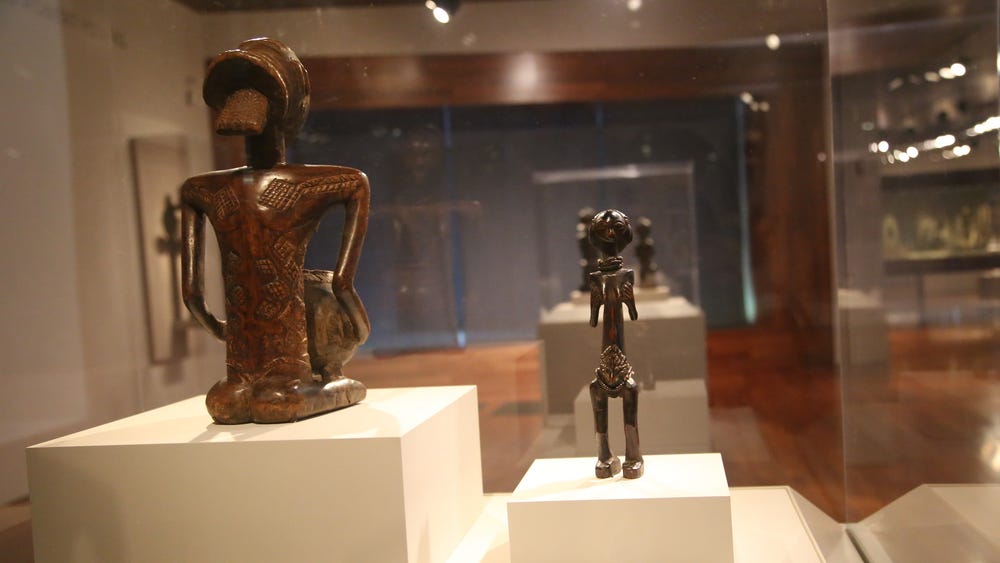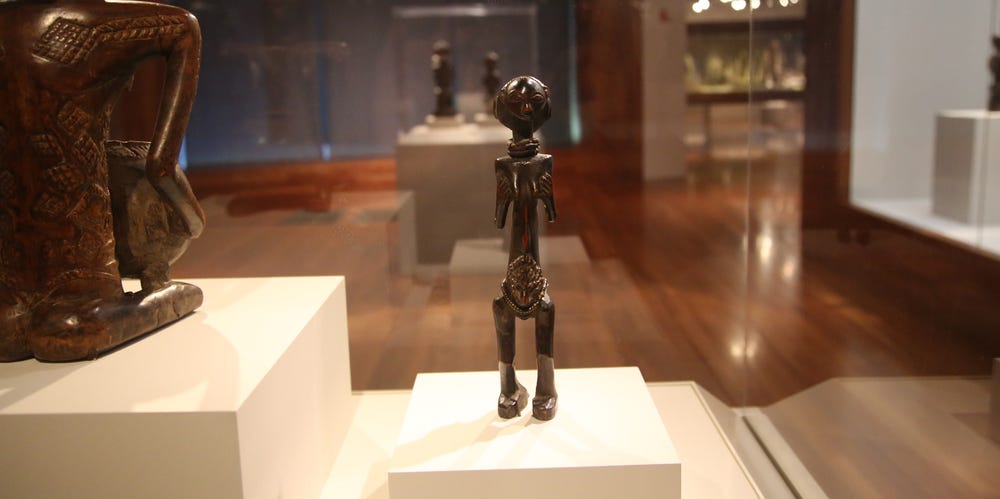A Luba Figure: An Expression of Ideals of Beauty and a Locus for Memory
By Mutombo Nkulu-N'Sengha, PhD, and Christina Hellmich
October 29, 2020
In the hands of the carver who made this sculpture, dynamics of power are expressed through a coded confluence of imagery. Though diminutive in scale, it is a grand representation of woman's ubiquitous power.
This possibly unique female figure in the corpus of Luba sculpture offers significant insights into the culture and worldview of the Congolese communities from whence it came. It is also the reflection of local aesthetic values in a world where the notion of “Buya” means both “beauty” and “goodness,” and where art is intimately intertwined with the enhancement of life and human flourishing.
The figure is distinguished by the fine detail of its elegant elongated form. It embodies concepts of beauty, memory, power, and authority in Luba culture, where women served important roles as spirit mediums, emissaries, and advisors to Luba kings and chiefs through the twentieth century (Petridis 2008, 45, and Roberts 2013, 68). Thin arms loop toward the chest with hands placed on the breasts in a gesture expressing a belief that only a woman’s body is strong enough to contain powerful spirits (such as the spirit of a chief or king) and “precepts of royalty” (Roberts and Roberts in Embodiments, 2015, 217).
—Mutombo Nkulu-N'Sengha, PhDThis figure, which expresses Luba ideals of beauty, also presents the female body as a locus for Luba memory, ‘the body as a book.’
Luba artist, Figure, 19th century, Democratic Republic of Congo. Wood, metal, and fiber, 10 1/4 x 2 x 1 7/8 in. (26 x 5.1 x 4.8 cm). Fine Arts Museums of San Francisco, Gift of Richard Scheller, 2019.1
Indeed, in a culture where breastfeeding in public is not seen as scandalous as it is at times in the West, breasts are not primarily viewed as erotic. The woman holds her breasts to stress her indispensable nurturing power as “alma mater,” the nourishing and bountiful mother, the educator in the mysteries of life and power. It is the woman who has a special connection with the ancestral spirits and the source of life. It is her that brings into the world kings and emperors, nourishes them, teaches them how to walk, talk or behave, and remain, in the exercise of power, their confident advisor. As the Baluba (plural for the people of Luba culture) have it: “kitako kya bulohwe I bana bakaji” (the foundation of kingship is in the hands of women). Beauty remains inseparable from the content of character.
Luba artist, Figure, 19th century, Democratic Republic of Congo. Wood, metal, and fiber, 10 1/4 x 2 x 1 7/8 in. (26 x 5.1 x 4.8 cm). Fine Arts Museums of San Francisco, Gift of Richard Scheller, 2019.1
In a world devoid of hermetic walls between the village of the living and the village of the ancestors, art is at once naturalistic and figurative. Intended to encapsulate the spirit of the ancestors and the principle of kingship, the sculpture expresses life-force through attractive aesthetics that convey the joy of life. The facial features of the figure are delicately rendered. A large coiffure adorned with copper-alloy beads extends down the neck, and a string of copper-alloy beads accentuates the hips, the fundamental locus of femininity, sensuality and love-making. When the figure was created, copper was scarce and highly valued (Herbert 1973, 179). The elongated torso brings our attention to a scarification pattern of keloids (or raised scars) that surrounds and emphasizes the umbilical hernia, the point of maternal contact. With scarification (ntaho), Luba art introduces us into the world of “tactile aesthetics” which heightens sensuality and enhances the desire and power of procreation. Beads and scarification are also mnemonic devices. For example, each bead is a morpheme—a unit of form and meaning purposefully placed or arranged. Luba scarification patterns are named and have specific meanings; a woman decides what patterns she will wear and how she will be seen by others.
These attachments and inscribed elements allow a knowing viewer or handler of the figure to “read” the sculpture. Women are acknowledged as the primary keepers of the history and memories of Luba peoples. This figure, which expresses Luba ideals of beauty, also presents the female body as a locus for Luba memory, “the body as a book.”
Luba artist, Figure, 19th century, Democratic Republic of Congo. Wood, metal, and fiber, 10 1/4 x 2 x 1 7/8 in. (26 x 5.1 x 4.8 cm). Fine Arts Museums of San Francisco, Gift of Richard Scheller, 2019.1
We are now open and thrilled to welcome you back safely to the de Young museum. You can see this Luba figure on view in Gallery 40. With your health and safety as our top priority, we’ve made some changes to create additional time and space for everyone.
Read Our Safety Plan
Text by Mutombo Nkulu-N'Sengha, PhD, Professor, Department of Religious Studies, College of Humanities, California State University Northridge and Christina Hellmich, curator in charge of the arts of Africa, Oceania, and the Americas and the Jolika Collection of New Guinea Art. This text is adapted from the upcoming selected works publication, de Young 125, available for presale in Spanish, Mandarin, and English from the Museum Stores.
Learn more about African Art at the de Young.
Further Reading / Sources Cited:
Petridis, Constantijn. 2008. Art and power in the Central African savanna: Luba, Songye, Chokwe, Luluwa; [published to accompany Art and Power in the Central African Savannah: Luba, Songye, Chokwe, Luluwa, an exhibition organized by the Cleveland Museum of Art ...]. Brussels: Mercatorfonds, 45.
Roberts, Mary Nooter, 2013. “The King is a Woman: Shaping Power in Luba Royal Arts.” African Arts 46, no. 3 (Autumn): 68-81.
Roberts, Allen F. and Mary (Polly) Nooter Roberts in Embodiments: Masterworks of African Figurative Sculpture, edited by Christina Hellmich and Manuel Jordan. San Francisco: Fine Arts Museums and Munich: DelMonico Books/Prestel, 2015, 216-217.
Herbert, Eugenia W. “Aspects of the Use of Copper in Pre-Colonial West Africa.” The Journal of African History. Vol. 14, No. 2(1973), 179.
Learn more about Luba culture.








